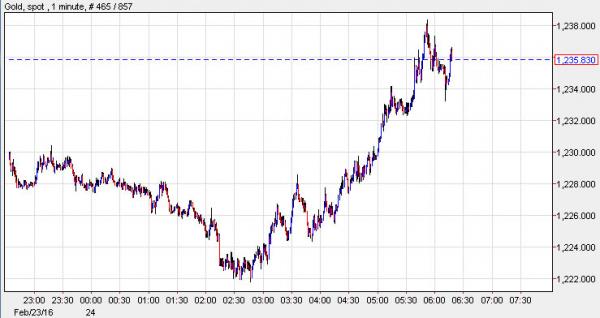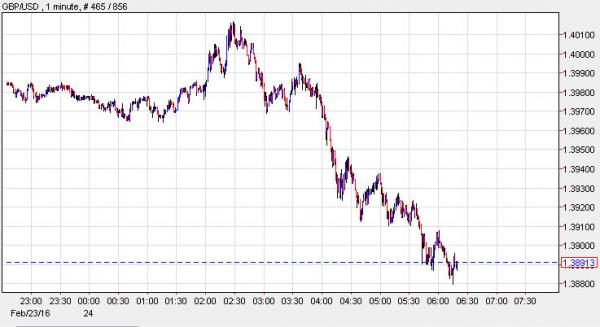While the prevailing dour (or perhaps sour) overnight mood was a continuation of the weak oil theme which started yesterday after Iran said the production freeze proposed by Saudi and Russia as “ridiculous”, and Saudi oil minister Al-Naimi said that Saudi won’t cut supply and that high-cost producers need to either“lower costs, borrow cash or liquidate” (ideally the latter), risk sentiment was further dented when BOJ Governor Kuroda says he won’t target FX rates or stocks, which is clearly nonsense, and further spooked Japanese asset prices (Nikkei -0.85), while sending JGB yields to fresh record lows as follows: 10-year at -0.055%, 20-year at 0.600%, 30-year at 0.915% and 40-year at 1.035%.
As Bloomberg adds, with the introduction of negative-rate policy, investors particularly banks are investing excess cash in govt bonds yielding more than zero, says Hideo Suzuki, chief manager, forex and financial products trading at Mitsubishi UFJ Trust & Banking, in an interview; says there’s a sense among investors that unless they buy positive-yielding debt now, they won’t be able to purchase them. Well there are always positive yielding US Treasurys, though maybe not for much longer.
Going back to oil, it seems that finally the headline chasing algos have run out of steam: “the Saudi comments stating the obvious that the output deal was really not a deal” is weighing on prices, says Global Risk Management oil risk manager Michael Poulsen, with API also pulling prices lower. It’s “maybe an overreaction to things that were clear days ago, so might be some bargain hunters cashing in their chips.”
“Once again we are seeing lower oil prices halting the emerging confidence in global markets,” added Ole Hansen, head of commodity strategy at Saxo Bank A/S. “Lower oil prices continue to raise concerns about EM growth, a credit event among weak oil producers and selling from sovereign wealth funds.”
So with the marketwide short squeeze now officially over, global selling of stocks has resumed, dragging down everything from banks to commodity producers as well as emerging markets, while in the US S&P futures have tumbled back down to, or rather just below, the psychological support level of 1900 (and below DeMark’s breach level) driven by another day of tumbling USD/JPY, but also by the latest surge higher in gold – something which according to Goldman which has by now been stopped out of its gold “short” means systemic risk is once again rising.

Indeed, the bullish euphoria that had gripped markets as recently as Monday is all gone: “It will take some time before market sentiment does turn,” Kerry Craig, global market strategist at JPMorgan Asset Management, told Bloomberg TV in Melbourne. “It’s still very pessimistic. Most investors are very risk averse. You need catalysts or triggers such as an oil price stabilization, clarity about what the Fed is actually going to do and what we see happening with the Chinese currency and economic data.”
How much changes in just 48 hours based on nothing but HFT algo stop hunting price action and a confirmation of what everyone already knew: that there will be no oil production cuts.
While the rest of the risk moves have seen the now all too familiar correlations (Treasuries in Europe and US surging as stocks tumble), another notable plunge has taken place in cable which continues to sell on Brexit fears and overnight dropped below 1.3900. Effectively Boris Johnson has had a more favorable impact on the British currency than a few hundred billion in BOE QE – the local stock market should be cheering on Brexit.

Oh, we almost forgot the key event of the night: Trump’s juggernaut in Nevada virtually assures him the GOP presidential nomination barring some calamity. The market is desperately trying to explain to itself if this is bullish or bearish for risk.
In summary: European shares dropped the most in two weeks and U.S. stock-index futures also sank. Crude fell through $31 a barrel in New York, after sliding last session, when Iran’s oil minister derided a plan forged by Saudi Arabia and Russia to lock production at January levels. The Russian ruble retreated with Malaysia’s ringgit and the pound weakened below $1.40 for the first time since 2009 on concern the U.K. may exit the European Union. The cost of insuring investment-grade corporate debt rose for the first time in three days, while Treasuries and the yen advanced.
Where markets stand now:
Global Top News













Leave A Comment